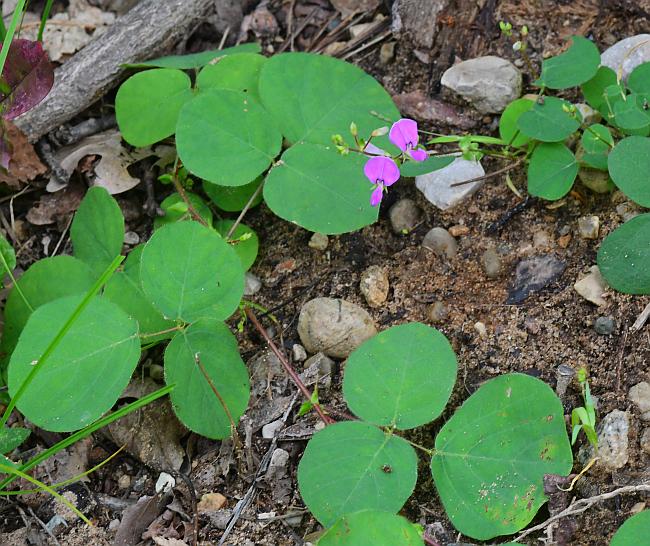Desmodium rotundifolium DC.
Dollarleaf

Native
CC = 6
CW = 5
MOC = 46
© SRTurner
Desmodium rotundifolium DC.Dollarleaf | |
 |
Native CC = 6 CW = 5 MOC = 46 |
© SRTurner |
|
Family - Fabaceae/Faboideae Habit - Perennial forb with a short, often woody rootstock and often a taproot. Stems - Prostrate, to 1.5 m, branched, the median portion moderately pubescent with straight, spreading hairs, sometimes also with sparse to moderate, hooked hairs.
Leaves - Alternate, trifoliate, petiolate, stipulate. Petioles of the median leaves 1-5 cm long, somewhat reduced toward the stem tip. Stipules 5-12 mm long, 3-5 mm wide, ovate (the base partially clasping the stem), tapered to a sharply pointed tip, at maturity brown and spreading to more commonly reflexed, persistent. Leaflets flat or nearly so, the undersurface with straight, spreading hairs, the network of raised veins inconspicuous to evident. Central leaflet 2-7 cm long, 2-6 cm wide, often slightly larger than the lateral pair, more or less circular to broadly ovate, broadly obovate, or somewhat rhombic, the tip mostly rounded. Lateral leaflets 2-4 cm long 2-4 cm wide. Stipels 1-3 mm long.
Inflorescences - Terminal and axillary loose racemes and panicles in the apical 1/3 of the stems, often unbranched, the axis with straight, spreading and hooked hairs. Stipules somewhat reduced in inflorescence. Primary bracts 4-6 mm long, ovate, tapered to a sharply pointed tip, mostly persistent. Secondary bracts 1.0-1.2 mm long, linear to hairlike, sometimes shed early. Flower stalks 6-22 mm long.
Flowers - Calyces green, densely pubescent with minute hairs and with sparse, long, straight, spreading hairs, especially on the lower lip, the tube 1.7-2.0 mm long, the lobes 2-3 mm long, triangular-acuminate, mostly equal. Corollas papilionaceous, 7-12 mm long, pink or rarely white, the nectar guides yellow and white outlined in purple. Standard 1 cm broad. Keels and wings to 9 mm long, glabrous. Keels connate. Wings connate basally to keels. Stamens diadelphous. Anthers greenish-yellow, 0.3-0.4 mm long. Ovary green, puberulent, 3-4 mm long. Style upcurved, 1.5 mm long, glabrous, green.
Fruits - Loments, straight in outline, the stalklike base 3-5 mm long, consisting of 3-6 segments, each 5-7 mm long and 3-5 mm wide, angled or more or less rounded on the upper margin, angled on the lower margin, with deeper indentations below, less commonly rounded and nearly equally indented above and below, with dense hooked hairs on the margins and scattered hooked hairs on the faces. Flowering - July - September. Habitat - Mesic upland forests, sand savannas, margins of glades, ledges and tops of bluffs, railroads, roadsides. Usually in acid soils. Origin - Native to the U.S. Lookalikes - None. Other info. - This distinctive species occurs in the southeastern half of Missouri, and in somewhat scattered fashion across much of the eastern half of the continental U.S. It is easily recognized even vegetatively by its prostrate habit and trifoliate leaves with round leaflets. It is most often found in areas of acidic soil. Photographs taken in Big Spring State Park, 8-20-03 (DETenaglia); also near Loda Lake, Newaygo County, MI, 8-29-2020, and at Don Robinson State Park, Jefferson County, MO, 9-16-2021 (SRTurner). |